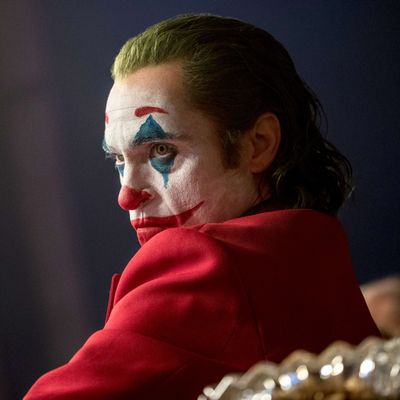
For its first two acts, Todd Phillips’s Joker is a social-realist drama that just so happens to be set in Gotham City. It’s the story of a troubled working-class man who crumbles under the depredation of an uncaring society, a plot inspired more by Martin Scorsese and Paddy Chayefsky than Tim Burton and Joel Schumacher. Of course, movies like that rarely make $93 million in their opening weekends, so the third act dutifully chronicles exactly how aspiring comedian Arthur Fleck becomes the green-haired supervillain of DC Comics lore. However, along the way, there’s a twist: Arthur has a severe mental illness, and over the course of the film the audience gradually learns that many things we thought we were seeing were not actually happening. Still trying to sort through it all? Let’s discuss which parts of the film we think were “real,” and which were delusions.
Arthur’s romance with his neighbor Sophie.
We’ll start with the most obvious one: If Sophie’s confusion upon seeing Arthur in her apartment didn’t catch you onto the fact that their relationship was all in his head, the movie helpfully flashes back to show us that Arthur was imagining her presence the whole time! (Bless this movie for swerving around one hoary romantic trope and plowing straight into another.) After Arthur’s reveries during the Murray Franklin show, the Sophie revelation confirms that even the movie’s supposedly straightforward scenes must not be taken as objective reality, and introduces us to the parlor game of guessing what else in the movie might be a fantasy. If you’re curious, this was also the scene that inspired the whole incel mishegoss: In the early version of the script that leaked online, Sophie’s interactions with Arthur were real but platonic, and he flew into a rage after seeing her have sex with another man. Cutting that out was one of Phillips’s rare acts of restraint.
Arthur walks out of Sophie’s apartment, seemingly without incident.
This one is less a question of whether we can believe what we’re seeing, and more a question of what we can infer from what we didn’t see. After a frightened Sophie asks Arthur to leave her living room, the film cuts to a shot of him walking back to his own apartment. We never see Sophie again after that, leaving some viewers to infer that she was one of Arthur’s many victims. I’m not sure I buy it, but the ambiguity does fit the film’s penchant for having it both ways — the movie gets to raise the specter of Arthur doing something terrible to Sophie, without having to deal with the consequences of showing him actually do it.
After unveiling his new persona as Joker on the Murray Franklin show, Arthur is taken away by the police, but escapes when his acolytes plow an ambulance into the cop car. Once freed, he exults in their adulation.
Talk about send in the clowns! Although in this case, ought there to be clowns? There’s no explicit indication that Joker’s moment of triumph is anything other than what it seems, but some viewers have seen what they think are hints that it should not be taken at face value. As the character’s grand apotheosis, it’s exactly the same sort of wish fulfillment as Arthur’s other delusions, and if the clown protesters are bound and determined to keep Joker out of jail, how come he’s in Arkham Asylum in the very next scene?
The final scene in Arkham
After I saw Joker, I was convinced that the movie’s final scene was a flashback to Arthur’s first stint in Arkham — showing that he was a violent threat even before the events of the film, and putting to lie all of his talk about being driven to evil by society, man. Admittedly, this hunch was based on little more than the fact that Arthur’s hair was black, not green, in the scene, and my powers of observation were dulled somewhat by the fact that I was packing up my things to go and not really paying attention. But still, think about it! Unfortunately, when I attempted to explain this fan theory to my co-workers, David Edelstein reminded me that the therapist in Arkham mentions the death of Thomas Wayne, which means it can’t be a flashback. Oh well. I guess I have a lot to learn about hair dye.
Everything after the fridge scene.
In the world’s most unexpected callback to Indiana Jones and the Kingdom of the Crystal Skull, late in the film Arthur becomes so distraught that he climbs into his own fridge. The Ringer’s Andrew Gruttadaro proposes that everything after this point is “a near-death hallucination” brought about by the lack of oxygen inside the appliance. It’s an interesting theory, but it comes with an unexpected wrinkle: If you make a movie about Joker, but the part where he becomes Joker is all a dream, did you really make a movie about Joker?
The entire third act of the movie.
Not to be outdone, there are those who consider the entire last half-hour of the movie to have taken place entirely in Arthur’s head. However, as my colleague Bilge Ebiri pointed out, this would mean that Arthur had a delusion of Sophie inside his existing delusion. Still, I don’t want to rule this one out entirely — if you’re already cribbing from the masters, what’s one more Chris Nolan movie?


